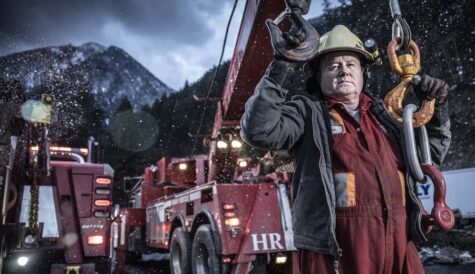Paws & Claws! Wildlife programming
With airtime and commissions tougher to come by, natural history producers are having to be increasingly inventive, especially if they want to make it into primetime. Stewart Clarke looks at how the genre has changed in recent years and what’s proving popular today.
The advent of pay TV and creation of channels dedicated to wildlife and natural history programmes was, initially, a boon for producers, distributors, broadcasters and viewers who tuned-in in droves. Then came the slump. With the benefit of hindsight, most now accept there was too much programming and too much poor quality programming, which turned off viewers and broadcasters.
Many of the free-to-air slots that were about a few years ago have gone and in an era of fragmenting audiences, license fees are under pressure.
"You could get away with watching paint dry as long as there was an animal in the shot" says Ellen Windemuth, MD of Netherlands-based producer/distributor Off the Fence, of the glut of programming a few years back. "But the market will continue to rid itself of mediocre product and films that shouldn’t get made won’t get made. Now you need the production values, special access and never seen before footage."
Do market conditions spell the end for natural history in primetime, have we seen the last of the classic shows that track a particular species or environment? The evidence suggests not.
As well as reports of an uptick in demand for classic wildlife shows, producers have become increasingly innovative. A new breed of programme blurs the lines of the natural history genre and folds in drama, reality, CGI, celebrity, science and other elements. The results can look very different from the shows of yesteryear, but provide a route into the wilds of primetime.
Ian Jones, president of National Geographic Television International, says the definition of natural history TV has changed. "Today it’s about putting people and animals in relation to the planet, it’s not about single-species observational docs. Every generation reinvents wildlife and natural history and what it means."
"There’s been more change in the past four or five years than in twenty before. [Producers] have a lot more tools at their fingertips." says Neil Harraway, director of production at Natural History New Zealand, the Fox-owned Kiwi producer of Most Extreme series.
Neil Nightingale, head of the BBC’s Natural History Unit, which is 50 this year, agrees the genre has changed considerably. He says: "What we’ve seen at the BBC and elsewhere is that natural history has exploded into other areas – as television has. There was a period when natural history seemed a bit precious, a bit special. It isn’t. There’s fantastic subject matter but in TV terms it’s not set apart from anything else."
While many bemoan the loss of space for natural history – Canal+, France 3, the BBC and others have all cut back slots in recent times – Nightingale points to new platforms and ways of distributing content. The live Spring Watch series for example is on BBC Two, but content and features are also aired on CBBC, local TV and the broadcaster’s radio stations.
The role of people and presenters in natural history programming is a contentious issue. While it can keep costs down, including presenters might also create a barrier to international sales.
The late Steve Irwin was a ratings winner but some critics questioned his methods. These questions equally apply to the likes of Nigel Marven and Austin Stevens. Andrew Jackson, managing director of Tigress, the UK producer of Austin Stevens Adventure, says: "Whenever Austin was with a snake we covered that for real, the bits in between were well storyboarded. I don’t see why we can’t put every filmmaking trick in the book in our portfolio."
Animal Planet did well with Steve Irwin’s Crocodile Hunter series and latterly has had Passion Pictures’ Saba and the Rhino’s Secret presented by Saba Douglas-Hamilton, daughter of the respected zoologist Dr. Ian Douglas-Hamilton (the show is Animal Planet’s first carbon neutral production).
How much room there is for more celebrity naturalists is questionable. "Everyone has their key faces, no-one is saying we desperately want more," says Mark Reynolds, head of factual at Granada International.
Using production experience and people from other genres is one way to ensure the storytelling aspects get proper attention. Tigress’ Jackson says: "Some producers don’t put filmmakers at the lead. They end up with wonderful shows but not with great stories."
Tigress and Thirteen/WNET New York have in the past worked with TV drama and movie producer Nigel Cole (Calendar Girls, Saving Grace) on celebrity wildlife shows including The White Elephants of Thailand with Meg Ryan and Wild Horses of Mongolia with Julia Roberts. Celebrities also frequently lend their voices to natural history shows, witness Meryl Streep’s upcoming voiceover of Feodor Pitcairn Productions and Off the Fence’s humpback whales film Ocean Voyager.
Until three years ago Austrian public broadcaster ORF had played mainly in the field of classic programming. It has since tried several new shows and will now invest in one or two experimental projects a year, says Walter Koehler, head of the natural history unit. One of the more experimental shows was The Wild of the West, a critically acclaimed one-hour film coproduced with Discovery, WDR and NDR, which employed a Clint Eastwood look-alike to tell the story of the wildlife and environments we see in western movies.
Less successful was Napoli Dogs, which played out a Romeo and Juliet story using stray Neapolitan dogs. The series was picked up by Nickelodeon and Al Jazeera Kids, but did not rate well. "It is a wildlife show, but in Germany it wasn’t a success, the audience saw it as a fake, which of course it was in a way. But it was based on true facts and they would also have turned away if we’d made a boring doc on stray dogs," says Koehler.
Giving animals human characteristics is one way to reach an audience that might not tune in otherwise. The BBC’s Echo of the Elephants films from wildlife photographer Martyn Colbeck dates back to 1993 and features Echo, a 50 year old matriarchal elephant and her extended family.
More recently Oxford Scientific’s Meerkat Manor, distributed by Southern Star International, has taken up the mantle. Billed as ‘a soap opera with a difference’ the show tells the story of a group of meerkats. The BBC also admits it heeded a lot of lessons from soaps and reality series when it made Big Cat Diaries.
Animal Planet is reversioning OSF’s Lemurs, which follows Madagascan ring-tailed lemurs. It was on Five in the UK in May (called Lemur Island). "We want more focus on particular characters," Animal Planet International general manager Phillip Luff says. "We want less about the natural history and more about the story and characters."
Computer generated effects have been used in several crossover shows. In six part series Prehistoric Park naturalist Nigel Marven interacts with CG versions of extinct animals. As a hybrid show targeting a family audience, it can fit into several slots and to date, distributor Fremantle has sold it to 52 broadcasters.
Programme executive producer Jasper James classifies the show as "fantasy factual". The challenge with Prehistoric Park compared to earlier show Walking with Dinosaurs was the level of interaction, with animals feeding and even a mammoth being shaved. Producers are under pressure to deliver more with each series. "Budgets don’t go up, but expectations do," says James. "We have to think of new techniques and ways of not leaning so heavily on the CGI."
CGI is expensive, Prehistoric Park cost £6 million ($11.9 million) and, while it is not possible to film dinosaurs, what it can add to mainstream wildlife shows is debatable. "In many films the subjects are dramatic enough, we rarely use CGI for natural history," explains Off the Fence’s Windemuth. "But we do use it a lot in natural history shows that have science elements."
Science and natural history is a popular mix and the results fit into slots set aside for either genre. MR-Film’s three-part series Nature Tech for ORF and ARTE examines how nature provides a technological blueprint that can help man, using film and CGI. It has proved popular in Germany and abroad where it has sold to Smithsonian in the US, Kultura in Russia and Wuhan in China.
But how far can producers push the natural history category before it becomes something else entirely? "Does that matter to the audience?" asks the BBC’s Nightingale. "It does blend into other genres, but from an audience perspective it doesn’t make a difference."



